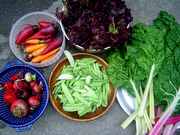

|
| Vegetable Varieties for Gardeners is a citizen science program
|
|
|
|
'Glamour' Tomatoes |
| |
| Sub-Category: |
Standard
Main-Season
|
| |
|
| Sub-Category 2: |
| | Description: |
Open pollinated. Main season standard type bred by the Birds-Eye Horticultural Research Laboratories, Albion, New York and released in 1957. Indeterminate plants produce clusters of 6 to 8 ounce, globe shaped red,thick walled, crack resistant fruits. Suitable for fresh and canning. Disease resistant variety. Resistance to Verticillium Wilt. About 75 days to maturity.
|
| Days To Maturity: |
75
|
| Seed Sources: |
Stokes Seeds - updated in 2014
Victory Seed Company - updated in 2014
Reimer Seeds - updated in 2014
|
| |
| Rating Summary |
| |
Overall: (4.0 Stars)
Taste: (5.0 Stars)
Yield: (5.0 Stars)
Ease/Reliability: (4.0 Stars) |
| |
| Reviews |
| |
Login to share your Review of Glamour.
Number of Reviews: 1
KEY: O=Overall Rating, T=Taste, Y=Yield, E=Ease
Reviewed on 07/31/2006 by
Randy
- An experienced gardener
|
 Overall Overall
 Taste Taste
 Yield Yield
 Ease Ease
|
Ontario, Canada
Frost Free Season: 123 - 143 days
Soil Texture: Clay
Garden Size: Medium - 400 square feet to 1,600 square feet
Sun Exposure: 6 to 8 hours per day
|
| I have planted Glamour in my garden for as long as I can remember. In fact, if I was limited to only one variety, it would be my choice. The fruits are the perfect slicing size, being smaller than a standard beefstake, but larger than most of the traditional varieties. The fruit is attractive, firm, juicy and with the appropriate sweetness and acidity. They are great sandwich and salad tomatoes.
I also like the fruiting formation, which bears evenly spaced fruit along a linear branch opposed to the usual cluster. This makes picking easier and results in less cramped or misshapen tomatoes.
The plants themselves tend to be very solid and robust. I have never grown a flimsy Glamour. |
| | | 2 of 2 gardeners found this review helpful.
|
|
|
|
|
Vegetable Varieties for Gardeners is a citizen science program, © 2004-2024, All Rights Reserved
Cornell Garden Based Learning, Cornell University College of Agriculture & Life Sciences, Horticulture Section
|






 VVfG home
VVfG home

